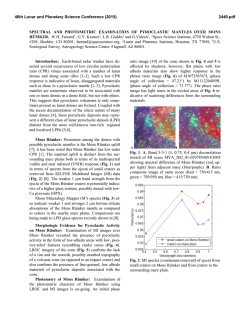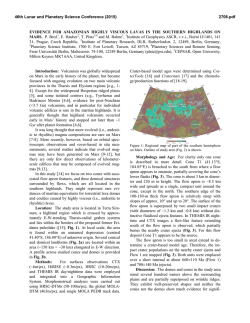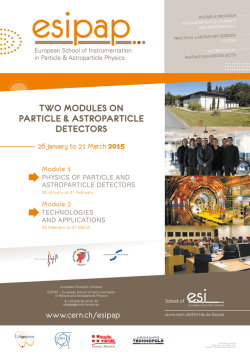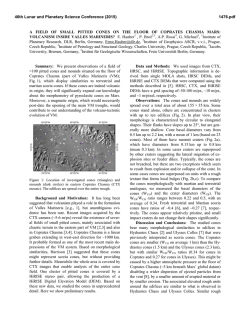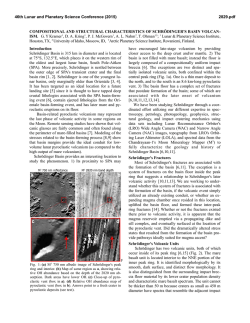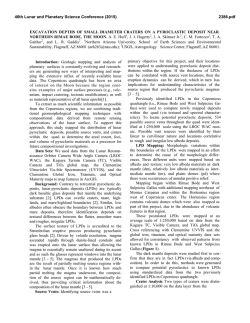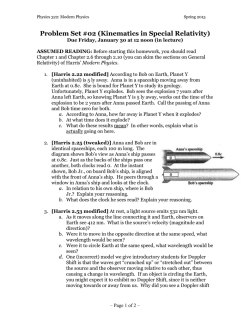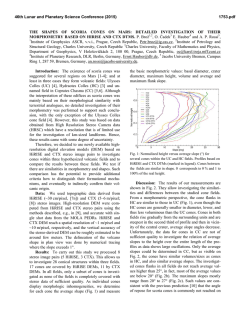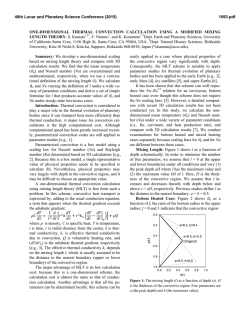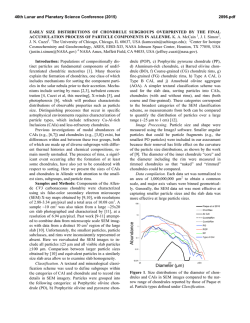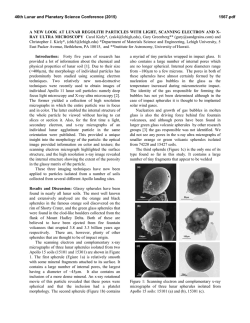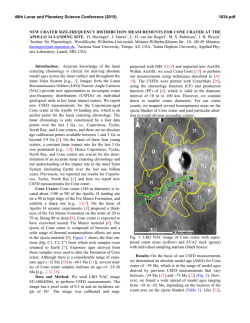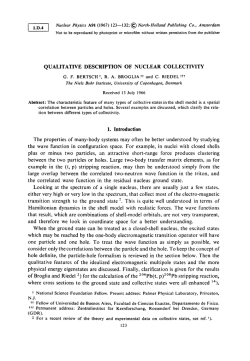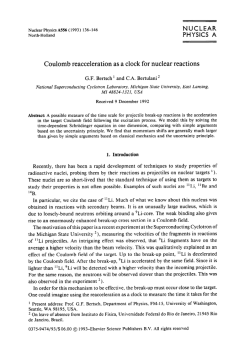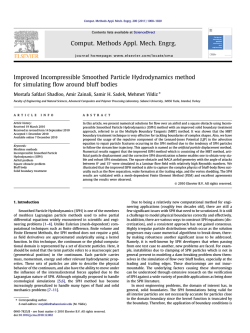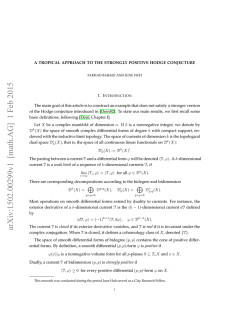
A pyroclastic origin for cones in Isidis Planitia: 1. Physical modeling
46th Lunar and Planetary Science Conference (2015) 2502.pdf A pyroclastic origin for cones in Isidis Planitia: 1. Physical modeling and constraints. Cailin L. Gallinger1 and Rebecca R. Ghent1,2, 1Department of Earth Sciences, University of Toronto, 22 Russell St, Toronto, ON M5S 3B1, Canada. mailto: [email protected]. 2Planetary Science Institute, Tucson, AZ, USA. Introduction: Isidis Planitia, a 1100 km-wide infilled impact basin in the eastern equatorial region of Mars, has been known since the Mariner missions to contain a geologic unit covered in highly organized surface features [1]. Originally called “thumbprint terrain”, high-resolution images from the Mars Odyssey THEMIS and the Mars Express CTX and HiRISE instruments have shown these features to actually be composed of multiple relatively small (200-1000 m diameter), evenly-sized, and evenly-distributed cones of contested origin [2]. We present herein the first of a three-part investigation that examines the possibility of a pyroclastic origin for these cones and the geologic unit containing them, building on previous work by Ghent et al. [3]. Pyroclastic volcanism has recently been shown to be a significant but oft-overlooked part of the Martian geologic record [4], and therefore finding evidence of its extent is especially important in understanding the evolution of the Martian crust and Martian igneous processes. Previous work: Cone chains in Isidis were mapped extensively by Hiesinger et al. [5]. They constrained the timing of cone formation to be contemporaneous with the emplacement of the AIi unit as defined by Tanaka et al. [6] through cross-cutting relationships with quasi-circular depressions (QCDs), which formed from differential compaction of the unit into craters after deposition. Lack of flow margin morphology implies the cones were formed from solid, particulate material. [3] proposed that devolatilization of a hot ash layer (or of volatiles underlying the deposition site) was readily capable of producing the observed cone Figure 2. Portion of THEMIS Night IR 100m Global Mosaic (v14.0) centered at 84.00E, 16.15N. Blue indicates regions of low thermal inertia that correspond to cone chain ejecta, which were averaged to obtain particle diameter estimates. sizes and numbers, even with volatile contents as low as 2.0 × 105 wt.%. Thus, we examine the other end of this scenario: the feasibility of a large pyroclastic flow being emplaced in Isidis under local conditions. Modelling pyroclastic density currents (PDCs): Pyroclastic density currents (PDCs) are complex, turbulent flows composed of a mixture of hot gases and suspended particles. In order to model a putative column-collapse PDC, we implemented a simplified box model which simulates a two-dimensional flow from a contained initial volume under the influence of gravity and atmospheric buoyancy, after [7]. The model obeys simple momentum, mass, and energy conservation laws, as well as basal friction incorporated into the Froude number (Fr). A constant particle-settling velocity ω was applied, as determined by the Newtown impact law [8]: where d is particle diameter (in m), Cd is the drag coefficient (taken to be 1 as in [8]), and g’ is the reduced gravity: Figure 1. Fig. 11 from Ghent et al. [3] showing cone chains (white lines), dense cone fields (yellow outline), QCDs (red and green circles), thermal boundary of the AIi unit (black arrows), and arrows indicating proposed direction of pyroclastic flow lobes. where g is the Martian gravitational acceleration (~3.7 m s−1) and ρp and ρ0 are the particle and background atmospheric densities, respectively. For this model, the interstitial gas density of the current is assumed to be equal to the background atmospheric density, and the gases are assumed to be incompressible. 46th Lunar and Planetary Science Conference (2015) 2502.pdf Table 1: Variable parameters used to test model runout lengths. Average (or typical) Min. value value Q0 m2 1.66 × 108 4.75 × 107 a -3 b ρp kg m 1900 700b c C0 0.067 0.05c -4 d m 4.16 × 10 1.19 × 10-4 d b Cd 1 0.44b e Fr 1.3 1.2e a c Ghent et al. (2012) [3] Dobran et al. (1994) [10] b d Dellino et al. (2005) [8] derived from thermal inertia – see text Variable Unit Finally, the concentration of particles suspended in the current is determined by: where C0 is the initial concentration of particles, hc is the height of the current (in m), and t is time (in s). The resulting runout length of the current was taken to be the length reached when the particle concentration dropped to zero. In the case of a dilute current released from an initial finite volume Q0 into a fluid depth much greater than the column height, the system of equations can be solved to give: A summary of the values for each of the parameters used and their sources is shown in Table 1. All values were obtained either through analysis of local conditions in Isidis (e.g. pressure from MOLA altitude) or through comparison to terrestrial pyroclastic flows. Most parameters had very little influence on the resulting runout length, and all results were within the range of several hundred km (compare with Figure 1). Derivation of particle size: The model employed here assumes a single, uniform particle size, whereas in a typical PDC the range of particle sizes can vary by several orders of magnitude. Therefore appropriate selection of a mean or typical particle size was crucial to constrain the model results. We utilized the method of [9] for determining particle size from thermal inertia values (TI, expressed in J m−2 s−1/2 K−1 or TIU) measured in dust-free regions of the Isidis basin as determined by both THEMIS and TES infrared measurements. We then calculated thermal conducitivies using the relation , where I is thermal inertia, κ is thermal conductivity in W m−1 K−1, ρ is density (in kg m−3), and c is specific heat capacity (in J kg−1 K−1), and assuming the product ρc is equal to 1.0 × 106 [9]. We then applied their eq. 17 to derive particle size from κ: where P is pressure in torr, d is the particle diameter in μm, B ≈ 0.0015 and K ≈ 8.1 × 104. As discussed in Min. runout length (m) 3.8 × 108 a 2.23 × 105 b 2000 4.72 × 105 c 0.1 4.45 × 105 -4 d 7.13 × 10 4.24 × 105 b 4 4.01 × 105 e 1.4 4.6 × 105 e Roche et al. (2013) [7] Max. value Max. runout length (m) 7.75 × 105 4.72 × 105 5.11 × 105 6.06 × 105 6.23 × 105 4.9 × 105 Jakosky et al. [10] and shown in Figure 2, there appear to be rings of material around the cones with a thermal inertia about 50 TIU lower than the surrounding plains. Assuming these represent ejected material from the cones, they are likely not welded or indurated, and thus their TI values would be the most accurate in determining the AIi unit particle size. Using these values (TI between 200-300 TIU), derived particle sizes are between 119 μm and 713 μm, corresponding to model runout lengths of 606 km and 424 km repsectively. Discussion and Conclusion: We implemented a 2dimensional box model of a pyroclastic density current with a single particle size to examine the possibility that the AIi unit and cones in Isidis Planitia are the product of a large, devolatilized pyroclastic flow. Our initial runout length estimates, constrained by local physical properties and comparison to terrestrial analogues, suggest that a single PDC would be capable of runout lengths comparable to those observed from cone distribution (see Figure 1). Based on analysis of cone chain directions in [3], there may have been at least three separate events that led to the formation of the AIi unit, all within close temporal proximity to one another. Ongoing work in completing this study concentrates on constraining the heat budget available after the flow has settled, and examining whether the scale of flow or thermal instabilities during/after the emplacement of the material correlate with the observed spacing between parallel cone chains. References: [1] Frey H. et al. (2000) LPS XXXI, Abstract #1748. [2] Bridges J. C. et al. (2003) JGR, 108(E1), 11–1-17 [3] Ghent R. et al. (2012) Icarus, 217, 169–183. [4] Michalski J. R. and Bleacher J. E. (2013) Nature, 502, 47– 52. [5] Hiesinger et al. (2009) LPS XL Abstract #1953 [6] Tanaka K. et al. (2005) USGS Scientific Investigations Map 2888. [7] Roche O. et al. (2013) Modelling Volcanic Processes, Cambridge University Press, 203-229. [8] Dellino P. et al. (2005), Geophys. Res. Lett., 32:21, L21306. [9] Presley M. A. and Christensen P. R. (1997b) JGR, 102(E3), 65516566. [10] Dobran F. et al. (1994) Nature, 367, 551-554.
© Copyright 2025
